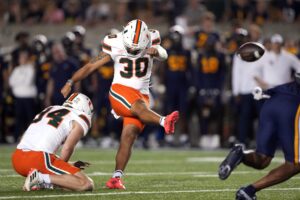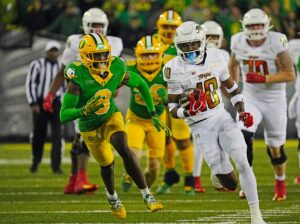Iowa has reached their bye week and it could not have come at a better time. The winning streak comes to an end at 12 wins, and they drop to 11th in the AP Poll. After demonstrating their worst home scoring performance since 2012, the Hawkeyes face the mid-season drawing board looking for some answers.
While this football team still has a lot of components that other teams would love to have, there are areas that need attention. The national perception of the remainder of Iowa’s schedule seemed manageable, with a likely road to Indianapolis. However, the parity within the Big Ten West has always made it a challenge to advance to the conference title game. The Hawkeyes experienced that difficulty last weekend, and face Wisconsin and Northwestern next. Both of which, like Purdue, have had Iowa’s number in recent years.
Pass Protection Deficiency
With time in the pocket, Spencer Petras has shown confidence and can deliver accurate throws. His adjusted completion percentage is nearly 70%. Pro Football Focus categorizes downfield passes with excellent ball location and timing as “big-time throws,” and he has three games with multiple throws of such. Iowa has playmakers with the ability to break loose when the ball is in their hands. With time, he can deliver to them. However, it’s a different story when Petras faces pressure.
In the Big Ten, Petras ranks second in defensive pressures with 74 on the season. He is getting pressured 33% of the time when he drops back to pass. Of those quarterback pressures, 25% have resulted in sacks. Without time in the pocket, routes cannot develop and he is left to throw it away or take a loss.
This starts with the offensive line. Typically, this unit is one of the best in the country and Iowa can play effective balanced football. This year, however, the line is young and has dealt with injuries. Outside of Tyler Linderbaum at center, there has been variability at the other positions. Cody Ince was out last week with an injury. Connor Colby left the Penn State game with an injury, but was active last week. Kyler Schott missed the first few games of the season with a foot injury.
The unit hasn’t been able to get its footing in terms of the regular starters, and that has hurt the chemistry, specifically in pass protection. The Hawkeye offensive line ranks 108th in the country and second to last in the Big Ten in pass blocking rating. For Iowa to see an improvement in the downfield passing game, the offensive line has to take a step forward.
Defensive Scheme
Phil Parker’s defense is one of the best in the country. Even after giving up 378 passing yards last week, Iowa still ranks second nationally in coverage defense and fifth in overall defensive rating according to Pro Football Focus. The problem arises when Iowa gets into a contest with an elite receiver. This happened last week with David Bell who put up 240 receiving yards and a touchdown. He had big numbers in 2019 and 2020 against the same Iowa defense as well.
Iowa runs a 4-2-5 defense with two deep safeties in the secondary, in what is typically called a cover two defense. The cover two gives you five underneath defenders that can cover the mid-range passing zone. This is extremely effective in protecting passing lanes and it’s a large reason Iowa has so much success in the interception game.
The five defensive backs on the field for the Hawkeyes are among the best in the country. Riley Moss and Matt Hankins were the top two rated cornerbacks according to Pro Football Focus entering last week. While Moss was injured, Hankins struggled to play to his potential. He gave up over 200 yards and was targeted 10 times with a 90% reception rate. Hankins also missed his first three tackles of the season. Purdue knew Iowa would have to respect the pass and they went at Hankins all afternoon. However, this isn’t just a result of Hankins’ coverage, it also has to do with Bell’s ability to break the coverage.
Cover Two Risks
The base of a cover two defense leaves two coverage safeties deep, and two cornerbacks covering the outside zones. The cornerbacks are tasked with multiple assignments during this coverage. The corner has to play the shallow receiver and any receiver that breaks behind him. A risk with this coverage is that a slot corner route can slip behind that cornerback if he bites too far on the shallow outside receiver. Bell ran this corner route twice on Saturday against the Hawkeyes, both resulting in completions.
Another risk of the cover two is losing outside containment. The cornerback has to stay on the sideline side of the receiver in order to funnel the receiver towards the inside of the field. This assists the safeties with breaking on the pass if it were to go to the outside receiver. When the cornerback loses that outside containment, there is no help on the back end. Bell was able to break this containment six times against Hankins. This was a product of Hankins’ padded coverage, and Bell’s pure athleticism. At times, though, he gave Bell too much room to operate. Bell was able to use that cushion and his speed to get to the outside for six catches. One of which resulted in a touchdown.
Bell also had two catches for 45-plus yards in the game. While they both broke the coverage, they were largely due to Bell’s skill set. The 60-yard pass in the second quarter was on a drag route at the line of scrimmage. They brought their receivers across to the near-side of the field, and it left no help on the far-side of the field. Bell’s speed allowed him to clear the corner and go for 60 yards. He also caught a long ball over the top of the defense, a play that Iowa rarely allows. Hankins kept his outside containment, but the safety bit on the play action and that allowed Bell to get behind the defense.
Recent Struggles With Elite Receivers
Iowa rarely allows this kind of performance from a receiver. But it’s worth noting that they seldom play this kind of receiver. In the last three seasons dating back to Bell’s first year at Purdue, there are three notable receivers that stood out with a similar skill set and athleticism. Those three were Tyler Johnson in 2019, Amon-Ra St. Brown in 2019, and Jahan Dotson in 2020. They recorded 170 yards, 163 yards, and 139 yards, respectively. Iowa won all three of those games against these receivers, however. While they did give up a lot of yardage on defense, the offense was able to score. In those three contests, Iowa averaged 38 points per game.
When elite receivers are faced with a cover two defensive scheme, oftentimes their athleticism can allow them to get to the gaps in coverage. Iowa has great defensive players, but their success on that side of the ball stems largely from coverage execution. When NFL talent lines up against any defense, they are going to find holes, it’s just a matter of containing them. Iowa could not contain Bell for the third season in a row, and this time it led to a loss.
Hawkeyes Face Mid-Season Drawing Board
The Hawkeye defense is built to bend and not break. But when the offense cannot get their footing, the defense can only do so much. Against Purdue, Iowa maintained their streak of allowing 24 points or less. Defensively, there were flaws, but wins come from more than just a stout defense. On the offensive side of things, the pass protection needs to take a step forward. With time in the pocket, Petras can be an effective quarterback. As the Hawkeyes face the mid-season drawing board, a few things need to be examined. At the end of the day, this is still the 11th ranked team in the country and they can still make the trip to Indianapolis. The pieces are in place, but some things need to be cleaned up.
[pickup_prop id=”13316″]






